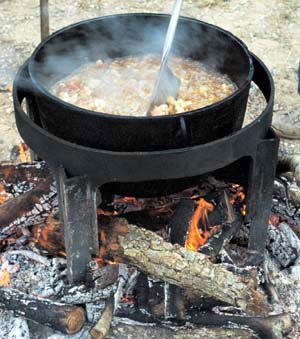|
Tar
Heel Travels
Cajun Country
It's 'bon temps' in the home of crawdads
and Jake Delhomme
 By
Bill F. Hensley By
Bill F. Hensley
Lafayette
is the heartbeat of Louisiana’s famed “Cajun Country,” a unique and
enjoyable ethnic region in this deep south land of French-speaking natives. I
knew I was in for a good time when I heard the battle cry “laissez les bon
temps rouler,” which means let the good times roll.
Life here revolves around good
food, drink and music, and every day is Mardi Gras. A true Acadian — known as
Cajuns — never met a party he didn’t like.
Cajuns are fun loving, hospitable people who can laugh at themselves. They work
hard and they play hard, and there are 700,000 of them in the largest
French-speaking area in the United States. You might be a Cajun, too, if the
horsepower of your outboard motor is greater than that of your car; you pass up
a trip to Europe to attend the annual Crawfish Festival in nearby Breaux Bridge;
or you give up Tabasco sauce for Lent.
There’s always a party somewhere in Acadania to celebrate such diverse things
as shrimp, frogs, sugar cane, omelets, pepper, wildlife, flowers, rice or even
days of the week. Occasionally, Cajuns will celebrate the fact that there is
nothing to celebrate.
My French has never been good, but even I could interpret many of the signs I
encountered. For example, I figured out that Rue Principle Sud means South Main
Street, and Rue Pont Est is East Bridge Street. Not bad for a Tar Heel hillbilly
If you look in the local telephone books, you will find a few Smiths and Browns,
but not many. There are, however, four pages of Broussards, two pages of
LeBlancs and Guidrys, and a lot of folks named Breaux, Boudreaux and Thibodeaux.
You’ll find some of the best cuisine in the world in these parts, so why not
eat and enjoy it? The food reflects the culture of the French-Canadians who were
exiled from New Brunswick and Nova Scotia in 1755 and settled here. In no time,
you will learn to like jambalaya, gumbo, etouffee, boudin, rice, gravy, cracklin
and bignets. Restaurants advertise “plate lunches,” a daily special or a
meat and vegetables. Fried alligator is often on the menu, and you absolutely
must flavor most dishes with a hot pepper sauce made locally. If the supply of
crawfish suddenly vanished, Cajuns would starve to death. And the spicier the
food, the better they like it.
When not eating, Cajuns are listening to music — called Zydeco (pronounced ZY-de-co)
— and dancing, a major pastime that can begin in the early morning and last
well into the night. Zydeco is a rare style that combines about every type of
music — jazz, country, blues and rock — with a Cajun twist. A band will
center around two instruments: an accordion and a “washboard,” but also
includes a guitar, bass and sometimes a fiddle.
At the CafÈ Des Amis in Breaux Bridge (the home of Carolina Panthers
quarterback Jake Delhomme), the dancing started at 8:30 on a Saturday morning
over coffee and bignets and lasted until well past noon. By that time, the drink
of the day was mimosas and Cajun bloody marys, and the small dance floor was
jammed with enthusiastic two-steppers, young and old, keeping time with the
lively beat. A 6-year-old local boy — with more energy than talent —
thrilled the crowd with his drum solos, and the dancing got wilder.
Visitors to the area are easily caught up in the friendly atmosphere of this
historic site, a popular destination as well as a jumping off place for such
larger Louisiana towns as New Orleans, Baton Rouge, Lake Charles and Shreveport.
There are good restaurants and hotels galore.
Lafayette has a modest downtown area of tree-lined streets, offices, shops,
museums, galleries and a half-dozen medium-rise buildings that overlook a park
where outdoor dancing is a weekly feature throughout the spring and fall. The
city recently has undergone a renaissance to enable art lovers to share the
sidewalks with coffee shops and antique stores.
A new art museum on the campus of the University of Louisiana at Lafayette has
opened to rave reviews and displays an eclectic offering of local, regional and
national art works, and enough Picassos and Wyeths to satisfy the artistic soul.
At nearby Evangeline Downs, there is thoroughbred racing from April through
Labor Day. The track is a favorite action spot for locals as well as tourists
who like to bet on the ponies.
To learn more about the history and culture of Acadians, there are two authentic
villages that feature homes complete with period furniture that reflect the
lifestyle of the early settlers. At Vermilionville, there are costumed
craftsmen, live music, cooking demonstrations and 17 structures in a 23-acre
park along the river.
And don’t miss the small towns nearby such as St. Martinville, New Iberia and
Abbeville, where stately homes and intriguing Cajun history come alive on every
corner.
On Avery Island, you can tour the Tabasco factory and learn that the renowned
sauce is sold in 120 countries around the world and has labels printed in 21
languages.
Everything is “bon temps” in Lafayette, whether it’s fishing in productive
waters, dining in Cajun or Creole restaurants, or dancing to a peppy Zydeco
band. For further information, call 800-346-1958 or visit
www.lafayettetravel.com.
|